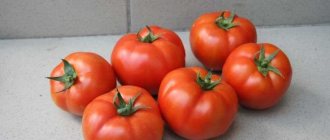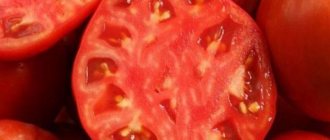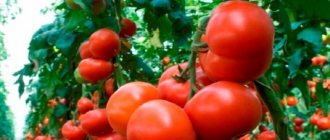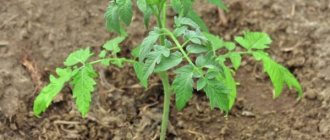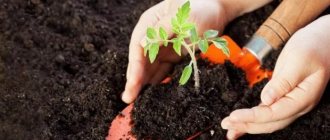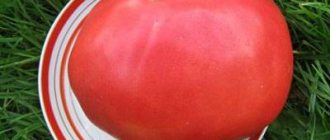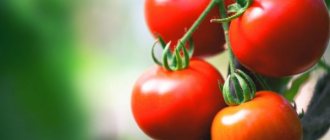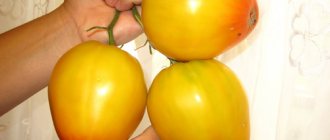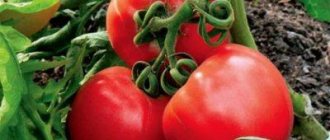Tomato “Red Red F1”: variety description
| Variety name | Red red F1 |
| general description | Mid-season, indeterminate tomato variety |
| Originator | Russia |
| Ripening period | 110-115 days |
| Form | The fruits are flat-rounded, with pronounced ribbing at the stalk |
| Color | Red |
| Average weight of tomatoes | 200 grams |
| Application | Belongs to the salad type |
| Productivity of the variety | 8 kg from 1 bush |
| Features of cultivation | Needs tying, shaping and pinching |
| Disease resistance | Has good disease resistance |
The tomato variety “Krasny Krasno F1” belongs to the early-ripening, high-yielding hybrids of the first generation.
The bush is indeterminate, spreading, with abundant formation of green mass, requiring shaping and tying up. The height of an adult plant reaches 2 m; in open ground the bushes are more compact. The green mass is abundant, the leaves are medium-sized, dark green. The fruits ripen in clusters of 5-7 pieces. Productivity is good; up to 8 kg of selected tomatoes can be harvested from a bush . Tomatoes “Krasny Krasno F1” are large, weighing 200 g. On the lower branches, the tomatoes are larger, can reach 300 g. The shape is flat-round, with pronounced ribbing at the stalk.
When ripe, the color changes from light green to deep red. The skin is thin, well protecting the fruits from cracking. The pulp is moderately juicy, fleshy, loose, sugary at the break, low in seeds. The taste is rich, sweet with a slight sourness. The fruits have a high content of sugars and beneficial microelements.
You can compare the weight of tomatoes of this variety with others in the table below:
| Variety name | Fruit weight (grams) |
| Red is red | 200 |
| Altaic | 250-500 |
| Russian size | 650-2000 |
| Andromeda | 70-300 |
| Grandma's gift | 180-220 |
| Gulliver | 200-800 |
| American ribbed | 300-600 |
| Nastenka | 150-200 |
| Yusupovsky | 500-600 |
| Dubrava | 60-105 |
| Grapefruit | 600-1000 |
| Golden Jubilee | 150-200 |
Diseases and pests
The hybrid has increased resistance to tomato diseases. But prevention doesn't hurt. The main thing is not to grow after nightshades.
Prevention indoors
- Ensure cleanliness.
- Renew the top layer of soil annually.
- When planting seedlings, pour potassium permanganate diluted to a pale pink color.
- Monitor humidity.
- Ventilate without allowing drafts.
Both indoors and outdoors
- Maintain crop rotation.
- The best predecessors: onions, legumes, carrots.
- Periodically treat with fungicides.
Tomato pests: thrips, aphids, whiteflies, Colorado potato beetles, slugs.
Insecticides are used against flying insects. They are used before the first flowers appear.
Aphids are removed with a pale pink solution of potassium permanganate.
Slugs are destroyed with ammonia (10 grams per bucket of water).
Thus, compliance with agricultural technology and prevention allows you to get a magnificent harvest of delicious tomatoes of your favorite variety.
Origin and application
The Red Red tomato variety was bred by Russian breeders and is intended for cultivation in different regions, except the northern ones. Closed ground is preferable: glazed greenhouses or film greenhouses. In areas with a warm climate, planting in open beds is possible. The collected fruits are well stored and can be transported. Tomatoes "Red Krasno F1", picked green, ripen quickly at room temperature.
The fruits are classified as salad fruits; they can be eaten fresh and used for preparing appetizers, salads, side dishes, soups, and purees. The smooth, beautiful fruits are stuffed and used to decorate dishes. Ripe tomatoes will produce delicious, sweet juice rich in amino acids.
Read on our website: the most common diseases of tomatoes in greenhouses and ways to combat them. Which tomatoes are resistant to most diseases and immune to late blight? What methods of protection against late blight exist?
Reviews from gardeners
Among the reviews about the variety, positive ones predominate. Many gardeners pay attention to the taste of fruits. Reviews from those who have already planted red tomatoes:
Valery Yu., 54 years old, Smolensk: “I planted these tomatoes as an experiment. I liked it. Massive bunches of tomatoes have grown, there are a lot of fruits on the bunch, all calibrated.”
Zinaida Vitalievna, 62 years old, Moscow region: “There was a very beautiful photo on the package with the seeds. I decided to plant it and then pickle it whole. They turned out to be too big, not a lot of them fit into the jar, there are empty spaces between the tomatoes. Marinated in halves. I liked the fresh ones: meaty and sweet.”
Katerina Anisko, 30 years old, Novotroitsk: “They look beautiful, round, but taste like ordinary tomatoes. They have a thick skin and store well.”
Advantages and disadvantages
Among the main advantages of the variety:
- good yield;
- tasty fruits suitable for salads and canning;
- high content of sugars and vitamins in ripe tomatoes;
- possibility of long-term storage;
- resistance to cold and drought;
- little susceptible to the main diseases of tomatoes in the greenhouse.
Among the features it is worth noting the need for proper formation of the bush, tying and removing stepsons. The tomato variety “Red Krasno F1” is sensitive to fertilizing; with a lack of nutrients, the yield is greatly reduced. Another drawback common to all hybrids is the inability to collect seed from ripe tomatoes.
You can compare the yield of a variety using the data below:
| Variety name | Productivity |
| Red is red | 8 kg per bush |
| Lazy | 15 kg per square meter |
| Rocket | 6.5 kg per square meter |
| Summer resident | 4 kg per bush |
| Premier | 6-9 kg per square meter |
| Doll | 8-9 kg per square meter |
| Stolypin | 8-9 kg per square meter |
| Broody | 10-11 kg per square meter |
| Black bunch | 6 kg per bush |
| Fat Jack | 5-6 kg per bush |
| Brawler | 9 kg per bush |
Variety value
Among the advantages of this tomato variety are the following:
- High undulating harvest - from one bush it is possible to collect approximately 6-8 kg of fruit.
- Long fruiting period - on average, fruiting occurs between the beginning of July and the end of September.
- The ability to plant in almost all areas - apart from the need for acclimatization in the northern regions of the country, this is undoubtedly an important quality.
- Strong immunity - the immunity of this variety is developed at a sufficiently high level, allowing it to avoid certain diseases and pests.
- Weather resistance - the variety is quite early and allows the growing bush to safely tolerate sudden temperature changes.
- The characteristics of the fruit are large-fruited, fairly good taste and a relatively long shelf life.
Among the disadvantages of the variety, the following are highlighted by many summer residents:
- The need to tie up and control the correct formation of the bush is a prerequisite for obtaining a high level of productivity.
- Constant removal of stepsons and specific requirements for soil and its annual renewal.
- Large fruit size is the main disadvantage if tomatoes are grown as one of the ingredients for home pickling and canning.
Features of cultivation
Growing a tomato “Red Krasno F1” is a labor-intensive process. It is propagated by seedlings. The best germination is achieved by seeds collected 2-3 years ago. Before sowing, it is recommended to treat them with a growth stimulator . Disinfection is not required; seed material undergoes mandatory disinfection before sale. Seedlings need light nutritious soil. A mixture of turf and humus or garden soil with peat is recommended.
For greater airiness, a small portion of washed river sand is introduced into the substrate. Wood ash, potassium fertilizer or superphosphate can increase nutritional value. The seeds are sown at a depth of 2 cm, generously sprayed with water and covered with film. For pecking, a stable temperature of at least 25 degrees is needed.
After the sprouts appear, the seedlings are exposed to light. On cloudy days it is illuminated with powerful fluorescent lamps. When young tomatoes throw out the first pair of true leaves, they are picked into separate pots and fed with liquid complex fertilizer. The second feeding is carried out 2 weeks later, before planting in the beds.
From mid-May, seedlings begin to be hardened by taking them out into the open air. The first walks last no more than an hour; after a week, the “Red Red F1” tomato is not left on the veranda or balcony all day. Transplanting tomatoes into a greenhouse or soil occurs closer to the beginning of June.
The earth is thoroughly loosened, wood ash or superphosphate is laid out in the holes. For 1 sq. m you can place no more than 3 bushes; thickening of plantings leads to a decrease in yield. A space of 100 cm is left between the rows.
After transplantation, the tomatoes begin to grow. Before flowering, the bushes can be fed with nitrogen-containing fertilizers, which allow them to quickly increase green mass. After all the tomatoes bloom, you need to switch to complexes containing phosphorus and potassium, which promote the formation of fruits.
Poor soils do not allow the formed ovaries to develop, and the fruits are small. Organic feeding with diluted mullein or bird droppings is also possible. However, they should not be abused; excess organic matter contributes to the accumulation of nitrates in fruits.
Tomatoes should be watered sparingly as the top layer of soil dries. Drip irrigation is very convenient in greenhouses and greenhouses. In between, the soil is loosened to provide air access to the roots.
Weeding is mandatory . To maintain a normal level of moisture, the soil can be mulched with peat, humus or straw. Growing tomatoes need to be shaped in a timely manner. It is preferable to grow in 1 stem. For better insolation, it is recommended to remove the lower leaves and trim the side shoots in a timely manner. The hands also need shaping.
To improve the development of ovaries, experienced gardeners pinch off deformed or weak flowers on the lower racemes. Tall plants are attached to trellises; as the fruits ripen, heavy branches must also be tied to the supports.
Landing
Seeds two years old give better germination. Before sowing, it should be treated with growth stimulants. There is no need to disinfect: they are disinfected before sale.
Sowing time is the last days of February, the beginning of March.
Work order:
- There should be a light nutrient soil. Garden soil is mixed with peat, river sand, and compost. Add the following mixture to the bucket: wood ash (a glass), potassium (15 g), phosphorus (30 g) fertilizers, urea (10 g).
- A container 15 cm high is filled with the prepared mixture.
- Plant the seeds at a depth of 1 cm.
- Having spread the seeds, water them and cover them with humus.
- Cover with glass or polyethylene.
- Place in a room where the temperature is slightly above 20 degrees.
- When shoots appear, the container is provided with the brightest place in the room. The lack of lighting is compensated by fluorescent lamps.
- The temperature during the week is reduced to 15 degrees during the day, and to 10 at night.
- Strong, stocky seedlings develop. Then it is increased to 25 degrees during the day, and left at 10 degrees at night.
- When the third true leaf is formed, they dive. Cardboard milk boxes and disposable plastic cups are filled with the above mixture and placed on pallets.
- Water with warm diluted pale pink potassium permanganate.
- For better survival, they are shaded. A day later they put it on the window.
- To prevent the seedlings from being pulled out, the trays are turned to the window with the other side every day.
- Control soil moisture. Water generously every 3 days. Better in the morning.
- After planting, 6 days later you should fertilize: one box of potassium chloride per bucket of water, half a matchbox of urea, one and a half boxes of superphosphate. The next one is in 2 weeks. Same composition. If plants are growing well, eliminate nitrogen.
Tomatoes are usually planted in a greenhouse on April 25–30. The date for planting in open ground is the first days of June. Dates are adjusted taking into account the conditions of the past winter. It is very important for the roots that the soil warms up well.
Care
Caring for the “Red-red F1” tomato does not differ from complex measures for other varieties of tomatoes: watering, periodic feeding, weeding and hilling. Each of the stages is important for obtaining the desired harvest, because the seedlings quickly begin to grow immediately after planting.
When growing tomatoes, some gardeners create special conditions for them with increased temperature and humidity, which contributes to the rapid development of plants. However, you should be careful with the air temperature in the greenhouse. When +35 °C is exceeded, the pollen of the hybrid becomes sterile, and you can get excellent growth and abundant flowering of plants, but you will not get fruit set.
Watering
Water the tomato with “Red-red F1” as needed when the soil dries out. The volume of watering is moderate. Water intended for irrigation is pre-settled and heated under the sun.
In greenhouses and greenhouses, it is better to organize drip watering of plants. It allows you to use water sparingly and deliver moisture directly to the roots of the tomatoes. Without drip irrigation, watering is done with a garden watering can, moistening only the roots of the plants. The event takes place in the afternoon, towards evening.
